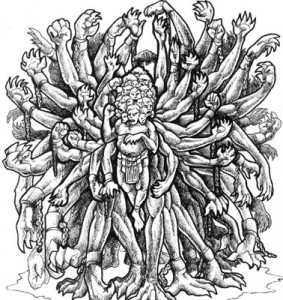Greek mythology is a vast tapestry of tales, where gods, mortals, and monsters interweave in stories of heroism, treachery, and fate. Among these tales, the story of Briareus, also known as Aigaion, one of the Hecatoncheires, holds a unique place.
These beings, with their fifty heads and hundred hands, were embodiments of the chaotic forces of nature. While the Hecatoncheires were initially feared and imprisoned by their own father, Uranus, due to their grotesque appearance, it was Briareus’s alliance with Zeus during the Titanomachy that truly marked his significance in the annals of Greek mythology.
Briareus Key Facts
| Origin | Uranus and Gaia |
| Parents | Gaia and Uranus (Some say Aigaion as father) |
| Defeated by | None, allied with Zeus |
| Siblings | Cottus and Gyges |
| Habitat | Initially Tartarus, later Olympus |
| Other names | Aigaion, Aegaeon |
| Roman name | Not directly translated in Roman myths |
| Associated with | Zeus, Titanomachy |
| Symbols | Hundred Hands, Storms, Fifty Heads |
Name and Etymology
The name “Briareus” is one of the most recognized among the Hecatoncheires. Intriguingly, he’s also known as Aigaion, a moniker that might have its roots in his lineage. The name Aigaion resonates with the essence of storms, and it’s believed that Briareus might have earned this name due to his descent from the god of stormy weather, Aigaion. This elder Aigaion was a deity who sided with the Titans during the Titanomachy, making the naming even more significant. While the elder Aigaion stood against the Olympian gods, Briareus, bearing the same name, played a crucial role in aiding Zeus, especially in securing the Ophiotaurus.
In Roman mythology, while there isn’t a direct counterpart for Briareus or Aigaion, the essence of such powerful beings transcends cultural boundaries.

Briareus’s Origin and Role
Born to the primordial deities Uranus and Gaia, Briareus, alongside his siblings Cottus and Gyges, was part of the earliest generations of divine beings. Their father, horrified by their appearance, imprisoned them in Tartarus. However, their destiny was not to remain chained. During the Titanomachy, Zeus, recognizing the potential of these giants, freed them. In gratitude, Briareus and his brothers sided with Zeus, playing a crucial role in the defeat of the Titans. Their allegiance to Zeus marked a transformation from outcasts to revered allies of the gods. Briareus’s unique connection to both the elder Aigaion and Zeus showcases the intricate dynamics of alliances and enmities in Greek mythology.
Depiction And Characteristics
Aigaion’s depiction is that of awe and might. With fifty heads and a hundred hands, he embodies chaos and overwhelming strength. Each hand, capable of wielding a boulder, made him an unparalleled force in battle. His form, while terrifying, also symbolizes the many facets of nature’s power, making him both a protector and a destroyer.
Beyond his physical prowess, Aigaion’s nature is complex. He isn’t inherently malevolent but embodies both the destructive and constructive forces of nature. After the Titanomachy, he became an ally of Zeus, guarding the gates of Tartarus and ensuring the imprisoned Titans remained confined. This role, from a feared giant to a guardian of cosmic order, showcases his multifaceted character.
Aigaion’s Symbols or Associations
Aigaion, with his hundred hands and stormy essence, is often associated with chaos, strength, and the untamed forces of nature. His role as a guardian of Tartarus post-Titanomachy also associates him with themes of justice, order, and balance.
Myths about Aigaion
The most pivotal myth involving Aigaion is the Titanomachy. Freed from Tartarus by Zeus, Aigaion, in gratitude, joined the Olympian god in his battle against the Titans. His participation, especially his ability to hurl boulders rapidly, overwhelmed the Titans, ensuring Zeus’s victory. Post-Titanomachy, Aigaion’s role shifted from a warrior to a guardian, emphasizing his transformation and the cyclical nature of power in Greek myths.
Representations In Art
While Aigaion isn’t as frequently depicted as some other figures from Greek mythology, when he does appear, it’s often in the context of the Titanomachy. His unique form, with its multitude of hands and heads, poses a challenge for artists, making any representation a testament to their skill and imagination.
Mentions in Ancient Texts
Aigaion, as Briareus, is prominently featured in Hesiod’s “Theogony,” a foundational text of Greek mythology. Hesiod provides a detailed account of his birth, imprisonment, and eventual alliance with Zeus. Another significant mention is in the “Bibliotheca,” traditionally attributed to Apollodorus of Athens. This work summarizes various myths, corroborating and expanding upon Hesiod’s account.
A quote from Hesiod’s “Theogony” encapsulates Aigaion’s awe-inspiring nature: “From their shoulders sprang a hundred arms, not to be approached, and each had fifty heads upon his shoulders, on their strong limbs.”
Frequently Asked Questions
Aigaion had two siblings: Cottus and Gyges.
Briareus is another name for Aigaion, emphasizing his stormy nature and immense strength.
Aigaion, after being freed by Zeus, played a crucial role in defeating the Titans during the Titanomachy.
He was initially imprisoned in Tartarus by his father, Uranus.
Aigaion became an ally of Zeus after the latter freed him from Tartarus. He then aided Zeus in the Titanomachy and later guarded the gates of Tartarus.
Featured Image Credit: Ghedoghedo, Public domain, via Wikimedia Commons
